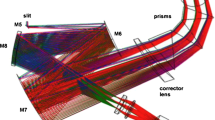Abstract
We have developed a wide-field mosaic CCD camera, MOA-cam3, mounted at the prime focus of the Microlensing Observations in Astrophysics (MOA) 1.8-m telescope. The camera consists of ten E2V CCD4482 chips, each having 2k×4k pixels, and covers a 2.2 deg2 field of view with a single exposure. The optical system is well optimized to realize uniform image quality over this wide field. The chips are constantly cooled by a cryocooler at − 80° C, at which temperature dark current noise is negligible for a typical 1–3 min exposure. The CCD output charge is converted to a 16-bit digital signal by the GenIII system (Astronomical Research Cameras Inc.) and readout is within 25 s. Readout noise of 2–3 ADU (rms) is also negligible. We prepared a wide-band red filter for an effective microlensing survey and also Bessell V, I filters for standard astronomical studies. Microlensing studies have entered into a new era, which requires more statistics, and more rapid alerts to catch exotic light curves. Our new system is a powerful tool to realize both these requirements.











Similar content being viewed by others
References
Alcock, C., et al.: Possible gravitational microlensing of a star in the large Magellanic Cloud. Nature 365, 621 (1993)
Aubourg, E., et al.: Evidence for gravitational microlensing by dark objects in the galactic halo. Nature 365, 623 (1993)
Udalski, A., et al.: The optical gravitational lensing experiment. Discovery of the first candidate microlensing event in the direction of the Galactic Bulge. Acta Astron. 43, 289 (1993)
Alcock, C., et al.: The MACHO project: microlensing results from 5.7 years of large Magellanic Cloud observations. ApJ 542, 281 (2000)
Udalski, A.: The optical gravitational lensing experiment. Real time data analysis systems in the OGLE-III survey. Acta Astron. 53, 291 (2003)
Alard, C., Lupton, R.H.: A method for optimal image subtraction. ApJ 503, 325 (1998)
Bond, I.A.: Real-time difference imaging analysis of MOA galactic bulge observations during 2000. MNRAS 327, 868 (2001)
Bennett, D.P., Rhie, S.H.: Detecting earth-mass planets with gravitational microlensing. ApJ 472, 660 (1996)
Udalski, A.: A Jovian-mass planet in microlensing event OGLE-2005-BLG-071. ApJ 629, L109 (2005)
Beaulieu, J.-P.: Discovery of a cool planet of 5.5 Earth masses through gravitational microlensing. Nature 439, 437 (2006)
Muraki, Y., et al.: Search for machos by the MOA collaboration. Prog. Theor. Phys. Suppl. 133, 233 (1999)
Yanagisawa, T., et al.: Wide-field camera for gravitational microlensing survey: MOA-cam2. Exp. Astron. 10, 519 (2000)
Sumi, T., et al.: Microlensing optical depth toward the galactic bulge from microlensing observations in astrophysics group observations during 2000 with difference image analysis. ApJ 591, 204 (2003)
Noda, S., et al.: Study of variable stars in the MOA data base: long-period red variables in the Large Magellanic Cloud - II. Multiplicity of the period-luminosity relation. MNRAS 348, 1120 (2004)
Abe, F., et al.: Candidate extrasolar planet transits discovered in the microlensing observations in astrophysics-I Galactic bulge data. MNRAS 364, 325 (2005)
Miyazaki, S., et al.: Subaru prime focus camera – Suprime-Cam. PASJ 54, 833 (2002)
Acknowledgements
This work is supported by a grant-in-aid for scientific research of the Japan Ministry of Education, Science, Sports and Culture. The authors are grateful to the staff of the National Astronomical Observatory Japan (Y. Kobayashi, S. Miyazaki, Y. Komiyama, H. Nakaya), to members of the Graduate School of Science (S. Sato, H. Shibai) and Instrument Development Group of the Technical Center of Nagoya University, to J. Hiraga in ISAS/JAXA, to staff of the Nishimura Co. Ltd., to H. Kondoh in AISIN, to A. Rakich in IRL and to B. Leach in ARC. Finally, the authors thank the anonymous reviewer for improving the manuscript and for general expert comments on the camera.
Author information
Authors and Affiliations
Corresponding author
Rights and permissions
About this article
Cite this article
Sako, T., Sekiguchi, T., Sasaki, M. et al. MOA-cam3: a wide-field mosaic CCD camera for a gravitational microlensing survey in New Zealand. Exp Astron 22, 51–66 (2008). https://doi.org/10.1007/s10686-007-9082-5
Received:
Accepted:
Published:
Issue Date:
DOI: https://doi.org/10.1007/s10686-007-9082-5




